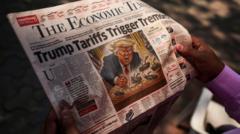As the world's fifth-largest economy grapples with rising tariffs and protectionism, its relative detachment from global trade flows may position it favorably amidst a slowdown affecting export-heavy nations.
India's Trade Detachment: A Possible Edge Amid Tariff Turmoil

India's Trade Detachment: A Possible Edge Amid Tariff Turmoil
India's inward-focused trade strategy may serve as a short-term advantage in the current global tariff climate.
India is currently navigating a complex trade landscape marked by increased protectionism and tariff fluctuations. While many economies are struggling with the repercussions of rising tariffs, India’s historically inward-focused trade policies may provide it with an unexpected shield against global economic shocks. Despite being the fifth-largest and swiftly expanding economy, India has been tethered by high tariffs and a modest share—less than 2%—of global exports.
Economists suggest that India's vast domestic market has been pivotal in sustaining its growth, likely outpacing global peers negatively impacted by declining exports. Rajeswari Sengupta, an economist at the Indira Gandhi Institute of Development Research, argues that India’s minimal exposure to international goods trade might work in its favor as global economies face mounting tariff pressures. "If export-driven economies encounter slowdowns, and we manage a steady growth rate of around 6%, we'll appear comparatively resilient, especially with our substantial domestic base to rely on," she expresses.
However, further trade liberalization is necessary for India to capitalize fully on new opportunities. India has a tangled history regarding trade barriers: even as other nations transitioned to more open trade policies in the 1960s, India clung to practices like import substitution, which stifled competitiveness and led to limited export growth.
The 1991 economic liberalization marked a shift, dismantling various import controls and boosting competitiveness. From 2002 to 2011, India's exports surged significantly, coinciding with a substantial increase in per capita income. However, protectionist tendencies resurfaced, especially after 2018, forcing economists to revisit the balance between domestic protection and global competitiveness.
Notable voices, such as Vivek Dehejia from Carleton University, emphasize that a lingering suspicion toward global commerce among policymakers can hinder India’s trade vitality. This has posed challenges to initiatives like Prime Minister Narendra Modi's "Make in India" campaign, aiming to bolster manufacturing yet leaving labor-intensive sectors vulnerable.
The potential for economic growth remains, especially as countries in the European Union seek dependable trade partners amid global uncertainties. Economists unanimously advocate for India to lower tariffs, enhance export capabilities, and adopt a friendlier approach to international commerce. Realizing this vision will likely depend on domestic reforms to streamline tariffs and improve trade processes.
Looking ahead, with significant changes in the international trade landscape, India must articulate a clear strategy for expanding its trade relationships. Failure to act might result in lost momentum as other countries refocus their economic alliances.
Economists suggest that India's vast domestic market has been pivotal in sustaining its growth, likely outpacing global peers negatively impacted by declining exports. Rajeswari Sengupta, an economist at the Indira Gandhi Institute of Development Research, argues that India’s minimal exposure to international goods trade might work in its favor as global economies face mounting tariff pressures. "If export-driven economies encounter slowdowns, and we manage a steady growth rate of around 6%, we'll appear comparatively resilient, especially with our substantial domestic base to rely on," she expresses.
However, further trade liberalization is necessary for India to capitalize fully on new opportunities. India has a tangled history regarding trade barriers: even as other nations transitioned to more open trade policies in the 1960s, India clung to practices like import substitution, which stifled competitiveness and led to limited export growth.
The 1991 economic liberalization marked a shift, dismantling various import controls and boosting competitiveness. From 2002 to 2011, India's exports surged significantly, coinciding with a substantial increase in per capita income. However, protectionist tendencies resurfaced, especially after 2018, forcing economists to revisit the balance between domestic protection and global competitiveness.
Notable voices, such as Vivek Dehejia from Carleton University, emphasize that a lingering suspicion toward global commerce among policymakers can hinder India’s trade vitality. This has posed challenges to initiatives like Prime Minister Narendra Modi's "Make in India" campaign, aiming to bolster manufacturing yet leaving labor-intensive sectors vulnerable.
The potential for economic growth remains, especially as countries in the European Union seek dependable trade partners amid global uncertainties. Economists unanimously advocate for India to lower tariffs, enhance export capabilities, and adopt a friendlier approach to international commerce. Realizing this vision will likely depend on domestic reforms to streamline tariffs and improve trade processes.
Looking ahead, with significant changes in the international trade landscape, India must articulate a clear strategy for expanding its trade relationships. Failure to act might result in lost momentum as other countries refocus their economic alliances.




















